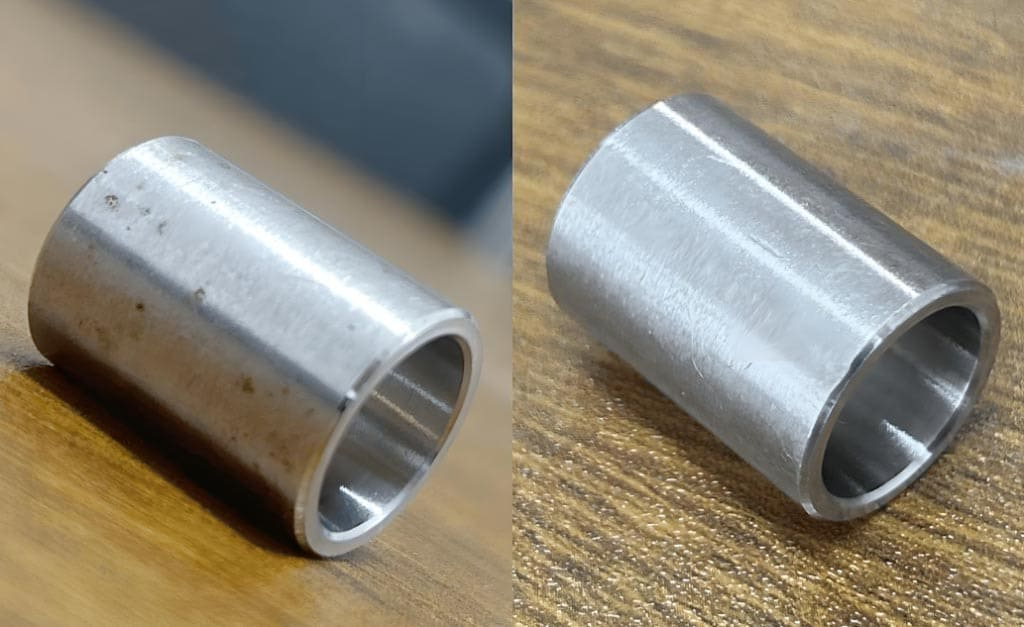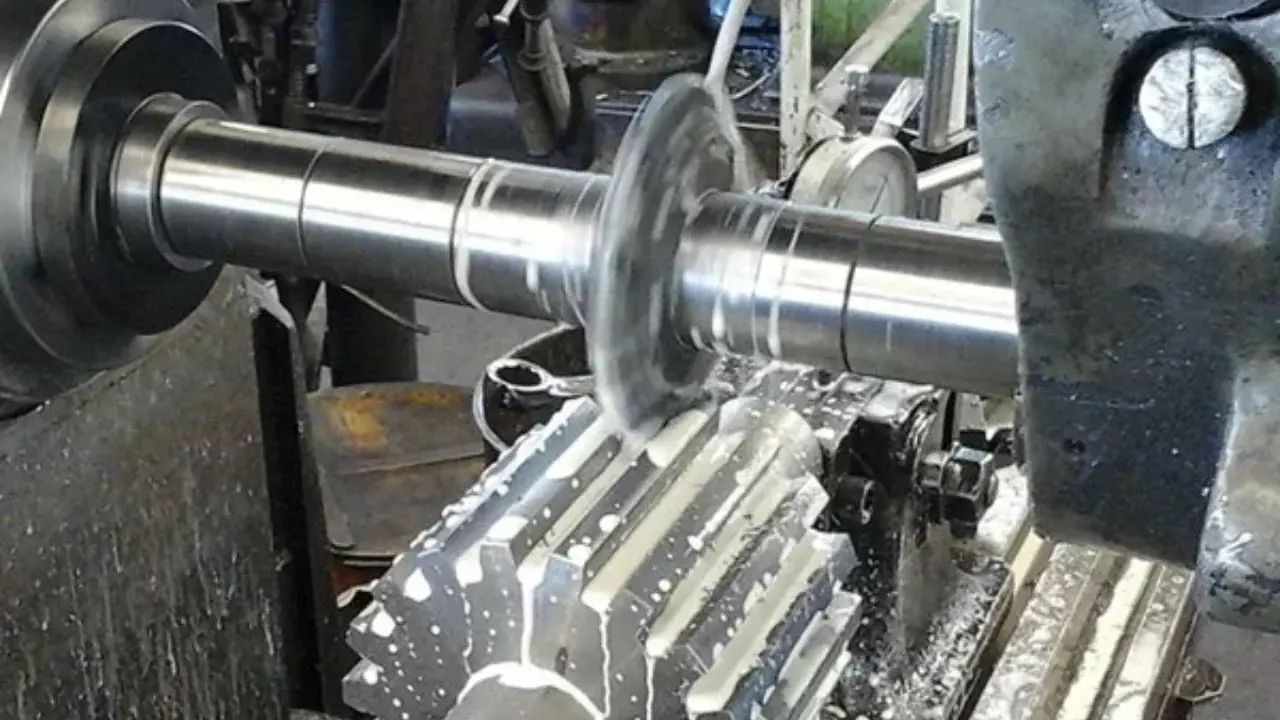Selection of the right material for a machine part is not that easy. Yes, there are a lot of factors that you have to consider, for example, strength, accuracy, endurance, and longevity. That’s why choosing between POM (Delrin) or PTFE(Teflon) is not a piece of cake.
So, to help you out in this case, this guide will compare both materials side-by-side so that you can choose the right material to save you time and money. Let’s dive in!

1) What is POM (Delrin)?
Polyoxymethylene is popular by its trade name Delrin or Acetal. Well, it is a high-performing plastic used in many precision parts that require high strength, stiffness, and good surface finish.
Homopolymer vs Copolymer
Polyoxymethylene has two types: homopolymers and copolymers.
- Delrin's Homopolymer POM offers greater strength because of its uniform structure, providing higher toughness.
- Delrin copolymer consists of hybrid molecules that offer better flexibility when it is exposed to chemicals, alongside heat, making them thermally stable.
Each variant offers particular advantages that fulfill different requirements.

- Key Characteristics:
POM has some popularity due to the following edges:
- High Strength to Weight Ratio: Well, it can hold shape under pressure.
- Dimensional stability: Apart from pressure, the shape doesn’t lose its integrity in high temperatures and humidity.
- Low-friction surface: Low-friction surface refers to a surface that experiences minimal wear when sliding against other materials.
- Good machinability: Good machinability means that POM can be cut cleanly without excessive wear on the cutting tools.
Alright! As POM has the combination of low friction surfaces and good machinability qualities, it makes it perfect for parts that require high strength, durability, long life, precision, and stability.
- Common Trade Names
You’ll find POM under several well-known names, for example:
- Delrin
- Acetal
- Celcon
- Ultraform
Each brand offers slight variations, but all share the same core properties. Generally speaking, if you're working on parts that need durability, smooth motion, and accuracy, POM is a smart and reliable option.
2) What is PTFE (Teflon)?
It was created under the name of Polytetrafluoroethylene. Most people know it as Teflon. It is a soft and slippery plastic most commonly used for nonstick pans but also finds application in industries dealing with heat, chemicals, and friction problems. And, it is used where most other plastics would simply melt, wear out or break into pieces.
Basic Chemical Composition
PTFE or material Teflon is usually made of two elements, carbon (C) and fluorine (F). PTFE’s chemical structure includes carbon chains that are fluorine surrounded which makes it very stable and strong.
Well, the bond guarantees that PTFE will retain its remarkable resistance to heat and chemicals. Apart from this, it does not easily react with strong acids, bases, or at elevated temperatures. That’s why laboratories, chemical plants, and places with high exposure to these conditions use PTFE.
- Key Characteristics:
Like other materials, PTFE also has distinctive features that set it apart from other plastics:
- Extreme Chemical Resistance: Bearing extreme temperature conditions is not a big deal for Teflon.
- Non-stick Surface: For frying pans, molds, or kitchen utensils made out of polymer, the nonstick power enables effortless cleaning with no residue adhesion.
- Ability to Withstand High temperatures: It can endure up to 260 °C (500°F), thus does not melt or soften flabby ulsters.
- Minimum friction: Teflon has about zero resistance, which makes it perfect for movable parts.
- Great Electric Isolation: Using PTFE in wires and cables offers complete electricity insulation because it does not conduct electricity.
Works well under challenging conditions that would damage other materials; these properties make Teflon a go-to choice for customers.

- Common Trade Names
PTFE is sold under several brand names, including:
- Teflon
- Fluon
- Hostaflon
- Dyneon
Each brand may offer different grades or variations, but all provide the same key benefits. If you need a material that resists heat, chemicals, and sticking, PTFE is a go-to choice. It’s widely trusted in the medical, food, chemical, and aerospace industries.
3) Machining Behaviour Comparison
When it comes to CNC machining, both POM (Delrin) and PTFE (Teflon) are widely used. They offer unique advantages but also come with their own set of machining challenges. Understanding how they behave during machining can help you get better results, as well as reduce waste and time.
Both POM and PTFE are chosen for CNC work because they are thermoplastics that can be cut, drilled, and shaped more easily than metals. POM is well known for its excellent machinability, while PTFE, although still considered machinable, requires more care.
| Material | Machinability | Surface Finish | Tool Wear | Dimensional Stability |
| POM | Excellent | Very good | Low | High |
| PTFE | Moderate | Fair | Low | Low |
Machining POM (Delrin)
POM is one of the easiest plastics to machine. It produces a smooth surface finish and holds tight tolerances. You’ll notice minimal tool wear, which means longer tool life and cleaner cuts.
- To get the best results:
- Use sharp tools with positive rake angles.
- Keep cutting speeds moderate to high.
- Ensure proper chip control, as POM can produce long, stringy chips.
- Watch out for thermal expansion—POM can warp if too hot during machining. Use coolants or allow it to cool between cuts.
Machining PTFE (Teflon)
PTFE is softer with a gummy feel, making it harder to machine. It does not keep its shape well under pressure and may deform easily strip threads.
- To effectively machine PTFE:
- Use very sharp tools and have slow cutting speeds.
- Provide good fixturing to keep the part stable.
- Add low-movement support with coolants or backup restraints.
- Cut light passes to reduce pressure in order to prevent stretching or distortion.
By understanding these behaviors, you can choose the right approach for each material and avoid costly machining errors
4) Physical and Mechanical Properties: Head-to-Head
Both POM (Delrin) and PTFE (Teflon) differ when considering their respective physical and mechanical attributes, as both possess unique strengths, weaknesses, and additional features. These characteristics will influence your final part’s performance in vivo.

a) Strength and Stiffness
POM outperforms PTFE in strength and stiffness. It has more resistance against pressure, which makes it perfect for rigid components like gears and bearings.
PTFE is soft; its elasticity means that it cannot support significant load, particularly in thin or unsupported sections, due to yielding.
b) Friction And Wear
Having one of the lowest coefficients of friction, PTFE is among the best options for rotating or sliding components requiring smooth movement.
While POM does have good low-friction wear resistance, he would not recommend it where constant sliding contacts would be present, compared to PTFE.
c) Temperature Resistance
Without breaking down or melting, PTFE can sustain much higher temperatures up to 260°C (500°F).
Heat rot POM starts losing shape at approximately 100-120°C. In high-temperature environments, parts might soften and become weaker.
d) Chemical Resistance
Withstanding most chemicals without negative effects makes PTFE nearly immune. It remains unreactive in harsh environments.
POM is not as chemically inert as PTFE but does resist many common chemicals. It may decompose in strong acids or bases.
e) Dimensional Stability
Even moderate heat and stress won't cause POM to lose its shape over time, making it retain its dimensional stability.
PTFE often experiences creeping and deforming over time due to sustained pressure or heat exposure.
5) Application Areas
Because of their distinct characteristics, both POM and Teflon coating have been applied in several industries. Each material performs best under specific conditions, such as stress, temperature, chemicals, and motion, for optimal productivity.
Applications of POM (Delrin)
- Automotive Industry
POM is frequently used in wear-resistant and durable components such as gears, bushings, and fasteners in the automotive industry. Moreover, it is also found within fuel system components as well as precision parts, aiding in the endurance reliability of engine and transmission systems.
- Electronics
In electronics, small and sensitive components are fabricated from insulators and electrically resistant materials, while switches and connectors are made from POM due to their durability under stress change.
- Industrial Uses
In industrial settings, POM has great mechanical performance for pumps and valves and integrated NEP straps for conveyor belts. And, its sliding properties reduce wear while preventing water absorption, increasing the service life of machinery.
- Medical Devices
POM is employed in the fabrication of surgical instruments, as well as handles and shells of tools and equipment. Well, POM is suitable for surgical tools because it has high strength and only limited contact with skin is safe.
Applications of PTFE (Teflon)
- Chemical Industry
PTFE’s capability to withstand harsh chemicals makes it ideal for gaskets, seals, valve seats, and lining pipes that carry reactive fluids.
- Food Processing
Due to its non-stick properties as well as being food-safe, PTFE finds application in baking sheets, food molds, mixer liners, and hoppers. Moreover, it aids in preventing the stickiness of food products and simplifies cleaning processes.
- Medical Field
Because PTFE does not react or interact with living tissue after implantation, it is used in catheters, tubing, and even some implants, making them biocompatible.
- Aerospace
PTFE is also used in aircraft for insulation of wires and bearing pads, as well as other components needing lightweight construction and heat resistance.
Alright! All these materials have their individual advantages, which assist you in selecting the appropriate plastic for your specific needs.
6) Pros and Cons
Both Delrin bars and Teflon possess distinct benefits along with notable drawbacks. Understanding each’s pros and cons assists in selecting the right material for the intended application.

Benefits of POM (Delrin)
+ Easy to machine: POM is ideal for precision, CNC machined parts as it retains tight tolerances and cuts cleanly.
+ High strength and stiffness: POM holds its shape well under load, making it suitable for mechanical components like gears and bushings.
+ Low friction: While not as slippery as PTFE, POM's surface remains smooth enough to offer low friction resistance for moving components.
+ Good wear resistance: POM can bear enduring motion without quickly wearing down.
+ Affordable in bulk: When used in high volumes, super POM becomes more cost-effective than many engineering plastics. This increases machining efficiency significantly.
Drawbacks of POM
- Lower chemical resistance: Strong acids, bases, and some solvents can damage the material.
- Heat sensitivity: Applications subjected above 100-120 degrees Celsius are unsuitable as POM starts losing strength at these temperatures.
- Moisture Absorption: While minimal, water absorption, slowly taking in moisture, can impact dimensional stability over time.
Benefits of PTFE (Teflon)
+ Excellent chemical resistance: Nearly all chemicals, including strong acids and solvents, cannot harm PTFE.
+ Non-stick surface: Ideal choice for components that need to avoid sticking, such as seals or cookware.
+ High heat resistance: Up to 260°C continuous temperatures do not break down PTFE, enabling the use of the material without restriction
+ Low friction: It is ideal for sliding mechanical components due to its exceptionally low friction coefficient among solid materials.
+ Biocompatible: For medical applications involving implants, tubing, and catheters, it is biocompatible.
Drawbacks of PTFE (Teflon)
- Difficult to machine: PTFE’s softness leads to a ‘gummy’ texture, which can cause deformation and result in poor tolerances alongside rough finishes during machining.
- Low mechanical strength: Under load, it performs poorly while exhibiting creep deformation over time under constant stress.
- High cost: In a thicker section, POM becomes more cost-effective than PTFE.
- Poor dimensional stability: Changes in pressure or temperature have a pronounced effect on shape retention. Thus, further making the chances of losing a precise fit extremely likely after some time.
Want to share a thing here that KU Leuven( an Organic Chemistry Doctorate) shared his review in a Quora post related to “Is Teflon toxic?”. The author said that Teflon is not toxic if you don’t overheat it. The author further said that it can pass through our gastrointestinal tract. You can read the comment in full here.

7) Which One to Choose? – Decision Guide
When considering POM (Delrin) versus PTFE (Teflon), certain conditions will favor certain materials better.
- Maximum Operating Temperature
If your part will be exposed to high heat, PTFE is the better choice. It can handle continuous use up to 260°C. POM, on the other hand, performs well only up to about 120°C.
- Exposure to Chemicals or Moisture
When it comes to harsh environments, PTFE is moisture- and solvent-resistant while also offering chemical resistance. POM has moderate protection but may be damaged after long-term contact with strong acids or bases.
- Tolerance and Surface Finish Needs
POM is perfect if your designs require exact dimensions, sharp edges, and polished surfaces, as it performs well in machining. PTFE performs poorly in machining, especially when greater precision is required. So, it poses a challenge due to its tendency to deform during cutting.
- Strength vs Softness
For tasks requiring rigidity, strength, and robustness, go for POM. Non-load-bearing components like seals may need to be made of PTFE.
- Cost and Volume Production
In large-volume projects, POM is usually cheaper and more economical than its counterpart. Custom thick shapes made from PTFE are particularly costly.
Recommendation Matrix
- Select POM (Delrin) for: tough parts used in moderate temperatures and standard chemical settings where precision and dimensional stability are important. Gears, fittings, and structural components easily make use of it.
- Select PTFE (Teflon) if: You are working in scenarios with high heat and a chemically aggressive environment, will require non-stick, low-friction parts, or are looking for sliding components. Alright! PTFE is perfect for seals and liners.
8) Final Thoughts
The choice of PTFE (Teflon) or POM (Delrin) relies on your requirements. If you need easy machining, strength, and precision, then POM is a great option. On the other hand, if chemical resistance with low friction and high heat capabilities is your priority, then PTFE is the best choice. Knowing these factors will help you better them and improve performance while lowering costs, and ensuring long-term reliability on all applications.




